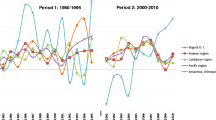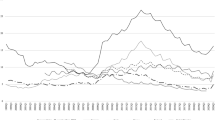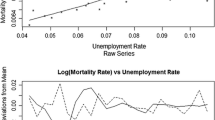Abstract
Despite the long-run strong negative association between economic development and mortality, their short-run relationship remains controversial. In the present work, we study co-movement between mortality growth (overall, gender- and cause-specific) and economic fluctuations in Italy over the period 1862–2013. To this aim, we use Johansen (Econometrica 59:1551–1580, 1991) procedure to jointly estimate the short- and long-run dynamics of the two variables, avoiding omitted variable bias in the cyclical co-movement extraction or spurious association attributable to trends. We also take into account possible asymmetric responses of mortality growth to shocks in GDP. We find that an increase of 1% in real GDP per capita induces a reduction in mortality rate of 0.27% for total population. Moreover, we observe that business cycle fluctuations do not affect mortality in the pre-wars era, where only the long run decreases matters driven by reduction in infections and accidents mortality. On the contrary, in the post-wars period, expansive phases of business cycle are associated with reduction in mortality growth and periods of recession generate an ever-deeper decrease. However, in this period, mortality for cancer is procyclical and significantly increasing in expansion: this reinforces the debate for controlling environmental factors.



Similar content being viewed by others
Notes
These findings are also supported by Johansen cointegration tests. There is strong cointegration outcome for infection and accidents. Weak cointegration results are detected for digestive (cointegration only at the 10% level of significance both with trace test and lambda max) and cancer mortality (cointegrated at the 5% with lambda max and 10% with trace test). No cointegration is found for deaths for circulatory diseases. These results are available upon request.
References
Ariizumi, H., Schirle, T.: Are recessions really good for your health? Evidence from Canada. Soc. Sci. Med. 74, 1224–1231 (2012)
Baffigi, A.: Il PIL per la storia d’Italia. Collana Storica Della Banca d’Italia Statistica, Roma, Marsiglio Editore (2015)
Barbiera, I., Dalla-Zuanna, G.: Population dynamics in italy in the middle ages: new insights from archaeological findings. Popul. Dev. Rev. 35, 367–389 (2009)
Bartoletto, S., Chiarini, B., Marzano, E., Piselli, P.: Business cycles, credit cycles, and bank holdings of sovereign bonds: historical evidence for Italy 1861–2013. In: Bank of Italy Economic History Working Papers, vol 43, pp. 1–43 (2017)
Bonamore, G., Carmignani, F., Colombo, E.: Addressing the unemployment-mortality conundrum: non-linearity is the answer. Soc. Sci. Med. 126, 67–72 (2015)
Brenner, M.H.: Mortality and the national economy: a review, and the experience of England and Wales 1936–1976. Lancet II 314(8142), 568–573 (1979)
Brenner, M.H.: Relation of economic change to Swedish health and social well-being, 1950–1980. Soc. Sci. Med. 25(2), 183–195 (1987)
Brenner, H.M.: Economic changes and heart disease mortality. Am. J. Public. Health. 61(3), 606–611 (1971)
Brenner, M.H.: Commentary: economic growth is the basis of mortality rate decline in the 20th century experience of the United States 1901–2000. Int. J. Epidemiol. 34, 1214–1221 (2005)
Cutler, D., Deaton, A., Lleras-Muney, A.: The determinants of mortality. J. Econ. Perspect. 20(3), 97–120 (2006)
Dickey, D.A., Fuller, W.A.: Distribution of the estimators for autoregressive time series with a unit root. J. Am. Stat. Assoc. 74(366a), 427–431 (1979)
Di Pietro, G.: Revisiting the impact of macroeconomic conditions on health behaviours. Econ. Hum. Biol. 28, 173–181 (2018)
Doornik, J.A.: Approximations to the asymptotic distributions of cointegration tests. J. Econom. Surv. 12(5), 573–593 (1998)
Gerdtham, U.G., Johannesson, M.: Business cycles and mortality: results from Swedish microdata. Soc. Sci. Med. 60, 205–218 (2005)
Gerdtham, U.G., Ruhm, C.J.: Deaths rise in good economic times: evidence from the OECD. Econ. Hum. Biol. 4, 298–316 (2006)
Global Burden of Disease Cancer Collaboration: The global burden of cancer 2013. JAMA Oncol. 1(4), 505–527 (2015)
Gonzalez, F., Quast, T.: Mortality and business cycles by level of development: evidence from Mexico. Soc. Sci. Med. 71, 2066–2073 (2010)
Gonzalez, F., Quast, T.: Macroeconomic changes and mortality in Mexico. Empir. Econ. 40, 305–319 (2011)
Janko, Z., Emery, J.C.H., Guenette, P.: (2013) The short-run and long-run relationships between mortality and the business cycle in Canada. Econ. Res. Int. Article ID 409738, 11 pages
Johansen, S.: Estimation and hypothesis test of cointegrating vectors in Gaussian vector autoregressive models. Econometrica 59, 1551–1580 (1991)
Kwiatkowski, D., Phillips, P.C.B., Schmidt, P., Shin, Y.: Testing the null hypothesis of stationarity against the alternative of a unit root. J. Econ. 54, 159–178 (1992)
Laporte, A.: Do economic cycles have a permanent effect on population health? Revising the Brenner hypothesis. Health Econ. 13(8), 767–779 (2004)
Lee, C., Kim, K.: Changing relationship between unemployment and mortality in South Korea. Health Econ. 26(12), 1630–1636 (2017)
Mattei, G., Pistoresi, B., De Vogli, R.: Impact of the economic crises on suicide in Italy: the moderating role of active labor market programs. Forthcom. Soc. Psychiatry Psychiatric Epidemiol. (2018). https://doi.org/10.1007/s00127-018-1625-8
Mattei, G., Pistoresi, B.: Unemployment and suicide in Italy: evidence of a long-run association mitigated by public unemployment spending. Forthcom. Eur. J. Health Econ. (2018). https://doi.org/10.1007/s10198-018-1018-7
McKinnon, J.G.: Numerical distribution functions for unit root and cointegration tests. J. Appl. Econ. 11(6), 601–618 (1996)
Neumayer, E.: Recessions lower (some) mortality rates: evidence from Germany. Soc. Sci. Med. 58, 1037–1047 (2004)
Preston, S.H.: The changing relation between mortality and level of economic development. Int. J. Epidemiol. 36(3), 484–490 (2007)
Ruhm, C.J.: Are recessions good for your health? Quart. J. Econ. 115(2), 617–650 (2000)
Ruhm, C.J.: Good times make you sick. J. Health Econ. 22, 637–658 (2003)
Ruhm, C.J.: Mortality increases during economic upturns. Int. J. Epidemiol. 34(6), 1206–1211 (2005)
Ruhm, C.J.: Healthy living in hard times. J. Health Econ. 24(2), 341–363 (2005)
Ruhm, C.J.: A healthy economy can break your heart. Demography 44(4), 829–848 (2007)
Ruhm, C.J.: Recessions, healthy no more? J. Health Econ. 42, 17–28 (2015)
Soares, R.R.: On the determinants of mortality reductions in the developing world. Popul. Dev. Rev. 33, 247–287 (2007)
Stevens, A.H., Miller, D.L., Page, M.E., Filipski, M.: The best of times, the worst of times: understanding procyclical mortality. Am. Econ. J. 7(4), 279–311 (2015)
Stuckler, D., Basu, S., Suhrcke, M.: The public health effect of economic crises and alternative policy responses in Europe: an empirical analysis. Lancet 374, 315–323 (2009)
Svensson, M.: Economic upturns are good for your heart but watch out for accidents: a study on Swedish regional data 1976–2005. Appl. Econ. 42(5), 615–625 (2010)
Svensson, M., Krüger, N.A.: Mortality and economic fluctuations: evidence from wavelet analysis for Sweden 1800–2000. J. Popul. Econ. 25, 1215–1235 (2012)
Tapia Granados, J.A.: Recessions and mortality in Spain, 1980–1997. Eur. J. Popul. 21, 393–422 (2005)
Tapia Granados, J.A.: Macroeconomic fluctuations and mortality in postwar Japan. Demography 45(2), 323–343 (2008)
Tapia Granados, J.A., Ionides, E.: The reversal of the relation between economic growth and health progress: sweden in the 19th and 20th centuries. J. Health Econ. 24(3), 544–563 (2008)
Tapia Granados, J.A., Ionides, E.: Mortality and macroeconomic fluctuations in contemporary Sweden. Eur. J. Popul. 27, 157–184 (2011)
Tapia Granados, J.A.: Economic growth and health progress in England and Wales: 160 years of a changing relation. Soc. Sci. Med. 74, 688–695 (2012)
Toniolo, G.: The Oxford handbook of the Italian economy since unification. Oxford University Press, Oxford (2013)
Vecchi, G.: Measuring wellbeing: a history of Italian living standards. Oxford University Press, Oxford (2017)
Acknowledgements
Work financially supported by FAR (2017) research Grant of the University of Modena and Reggio Emilia, Italy. We are grateful to the Editor-in-Chief and two anonymous referees for their very useful suggestions and remarks which improved the final version of the paper.
Author information
Authors and Affiliations
Corresponding author
Additional information
Publisher's Note
Springer Nature remains neutral with regard to jurisdictional claims in published maps and institutional affiliations.
Rights and permissions
About this article
Cite this article
Cavicchioli, M., Pistoresi, B. Unfolding the relationship between mortality, economic fluctuations, and health in Italy. Eur J Health Econ 21, 351–362 (2020). https://doi.org/10.1007/s10198-019-01135-1
Received:
Accepted:
Published:
Issue Date:
DOI: https://doi.org/10.1007/s10198-019-01135-1




